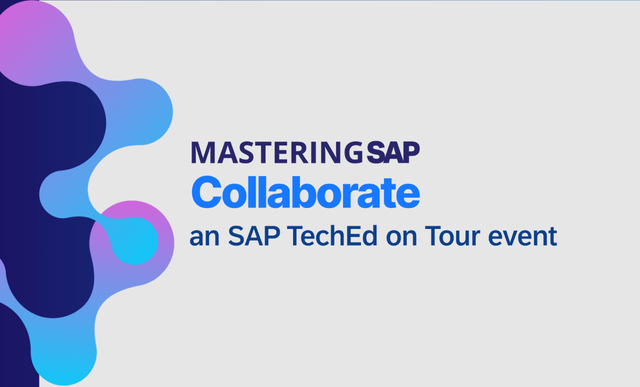SAP Container Platform
Filter By
Browse By
- SAP Analytics and AI
- SAP Application Development and Integration
- All SAP Application Development and Integration
- SAP ABAP
- SAP ABAP Development Tools
- SAP ABAP Test Cockpit
- SAP API Management
- SAP BAPI
- SAP Basis
- SAP BRF
- SAP Business Application Studio
- SAP CMS
- SAP Design Studio
- SAP Development Tools
- SAP DevOps
- SAP EAI
- SAP EDI
- SAP Extension Suite
- SAP Fiori
- SAP Fiori Elements
- SAP Integration Suite
- SAP Low Code Application Development
- SAP Low Code Automation
- SAP Netweaver
- SAP Release Management
- SAP UI5
- SAP Web Application Server
- SAP Web IDE
- SAP Business Process Management
- SAP Center of Excellence
- SAP CIO
- SAP Customer Experience
- SAP Data and Data Management
- All SAP Data and Data Management
- SAP BW
- SAP BW/4HANA
- SAP Crystal Reports
- SAP Data Archiving
- SAP Data Center
- SAP Data Governance
- SAP Data Integration
- SAP Data Migration
- SAP Data Quality
- SAP Data Services
- SAP Data Strategy
- SAP Data Visualization
- SAP Data Warehouse Cloud
- SAP DMS
- SAP Document Control
- SAP EIM
- SAP ETL
- SAP ETL Tools
- SAP HANA
- SAP HANA Administration
- SAP HANA Deployment Infrastructure
- SAP HANA Studio
- SAP Master Data
- SAP Master Data Governance
- SAP MDM
- SAP Enterprise Architect
- SAP Enterprise Asset Management
- SAP ERP
- SAP Finance
- All SAP Finance
- SAP Accounting
- SAP AR AP
- SAP Asset Accounting
- SAP Billing Systems
- SAP BPC
- SAP BRIM
- SAP Cash Management
- SAP Central Finance
- SAP Controlling
- SAP COPA
- SAP Cost Center Accounting
- SAP Currency Risk
- SAP e-invoicing
- SAP FICO
- SAP Finance Automation
- SAP Advanced Financial Closing
- SAP Financial Consolidation
- SAP Financial Planning
- SAP FX Risk
- SAP General Ledger
- SAP Global Tax Management
- SAP Hyperion
- SAP Order to Cash
- SAP Payment Processing
- SAP Profitability Analysis
- SAP Rebate Management
- SAP S/4HANA Finance
- SAP SWIFT Compliance
- SAP Treasury Management
- SAP Universal Journal
- SAP Governance Risk and Compliance
- SAP Human Capital Management
- SAP Intelligent Technologies
- SAP Platform and Technology
- All SAP Platform and Technology
- SAP Business Technology Platform
- SAP Cloud
- SAP Cloud Connector
- SAP Cloud Integration Platform
- SAP Cloud Migration
- SAP Cloud Platform
- SAP Cloud Providers
- SAP Cloud Strategy
- SAP Digital Signature
- SAP Container Platform
- SAP HANA Enterprise Cloud
- SAP Digital Asset Management
- SAP Smart Forms
- SAP HEC
- SAP Digital Integration Hub
- SAP Hyperscalers
- SAP Infrastructure
- SAP Messaging
- SAP Quality and Testing
- SAP Security
- SAP Spend Management
- SAP Supply Chain Management
- All SAP Supply Chain Management
- SAP APO
- SAP Asset Management
- SAP Business Network
- SAP Digital Manufacturing Cloud
- SAP Digital Twin
- SAP EWM
- SAP IBP
- SAP Inventory Management
- SAP Label Printing
- SAP Logistics
- SAP Manufacturing
- SAP Manufacturing Automation
- SAP MES
- SAP MII
- SAP MM
- SAP MRO
- SAP MRP
- SAP Order Management
- SAP Plant Maintenance
- SAP PLM
- SAP Production Planning
- SAP S&OP
- SAP SD
- SAP SPM
- SAP Supply Chain Planning
- SAP Track and Trace
- SAP Transportation Management
- SAP System Administration
What Is a Container Platform?
A container platform is software that creates, manages, and secures containerized applications. Container management software allows for easier, faster networking and container orchestration. These platforms handle containerized application processes, such as governance, automation, layered security, extensibility, and enterprise support.
There are several types of container platforms:
- Container engines, like Docker and Docker Enterprise Edition, provide a container runtime environment, which enables organizations to create containers, manage container images, and perform basic operations.
- Container orchestrators, such as Kubernetes, enable organizations to manage, govern, and automate containers at scale.
- Managed container platforms, like Google Kubernetes Engine, augment container engines and orchestrators with additional services, like management of the orchestrator and underlying hardware resources.
What Is a Container Platform?
A container platform is software that creates, manages, and secures containerized applications. Container management software allows for easier, faster networking and container orchestration. These platforms handle containerized application processes, such as governance, automation, layered security, extensibility, and enterprise support.
There are several types of container platforms:
- Container engines, like Docker and Docker Enterprise Edition, provide a container runtime environment, which enables organizations to create containers, manage container images, and perform basic operations.
- Container orchestrators, such as Kubernetes, enable organizations to manage, govern, and automate containers at scale.
- Managed container platforms, like Google Kubernetes Engine, augment container engines and orchestrators with additional services, like management of the orchestrator and underlying hardware resources.
What is an SAP Container Platform?
SAP Business Technology Platform, Cloud Foundry environment, supports Docker containers, Kubernetes for virtualization, and containerization.
SAP HANA Express can use Docker containers to build scalable applications.
SAP has developed several open-source Kubernetes projects:
- Gardener, an open-source project offering operation of Kubernetes clusters as a service.
- Kyma, a cloud-native application runtime that combines Kubernetes with a set of tools and open-source components to develop, run, and operate cloud-native applications.
In addition, SAP uses Kubernetes for SAP Data Intelligence cloud service and SAP Data Hub on-premise enterprise data orchestration solution.
Further Resources for SAPinsiders
The Role of Containers in Digital Innovation. In this webinar, Chris Urwin, Head of COE, DevOps, SUSE, discusses how container-based, cloud-native apps orchestrated by Kubernetes are becoming the building blocks of the modern IT infrastructure. Urwin describes how containers can help organizations solve business challenges.
752 results
-

- SAP API Management
 Premium
Premium
What You Need to Know About MDM-Portal Integration
Reading time: 31 mins
Explore the four methods—MDM Business Package, MDM Web Dynpro Configurator, MDM Web Services, and MDM Java API—from which you can choose to integrate SAP NetWeaver Master Data Management (SAP NetWeaver MDM) and SAP NetWeaver Portal. Learn how and when to implement the integration method that best addresses your business structure, and then take that integration...…
-

 Premium
Premium
A Step-by-Step Guide for Uploading External Documents to a DMS via DIR
Reading time: 10 mins
Kamal Jain demonstrates how to upload external documents onto the SAP Document Management System (DMS) content server via a Document Information Record (DIR) for FI transaction codes FB02 and FB03. Key Concept Normally when you upload a document using transaction codes FB02 or FB03, it would be stored in the SAP database as an object,...…
-

 Premium
Premium
How to Use HANA’s Geospatial Capabilities
Reading time: 10 mins
SAP HANA’s spatial feature is part of a platform that stores both geospatial and business data. Akash Kumar shows how to use it to perform operations such as distance calculation between objects, the union of objects, and analytics on spatial data. Key Concept Geospatial HANA allows users to store massive amounts of data in real...…
-
-

 Premium
Premium
What the Wizards Don’t Tell You About Intrastat Reporting
Reading time: 22 mins
Enterprises based within a member state of the European Union (EU) are legally required to report their goods movements to and from other member states. These reports are called Intra European Community Trade Statistics (Intrastat) reports. In most cases, this requirement also applies to European subsidiaries of American companies. The author explains how to set...…
-

 Premium
Premium
Use Global ATP to Trigger Time-Based Location Substitution in a Consolidation Environment
Reading time: 14 mins
Learn how to implement time-based location substitution using rules-based Available-to-Promise (ATP) in a consolidation scenario. An example from the chemical industry demonstrates how to set this up. Key Concept Inclusive rule strategies are used to determine the domain of products and the location substitutions that are possible based on the rules defined within the inclusive...…
-

 Premium
Premium
Maintain an Asset Hierarchy Using the Plant Information Catalog in SAP MII
Reading time: 34 mins
Learn how to create, maintain, and consume a Plant Information Catalog (PIC) hierarchy in SAP Manufacturing Integration and Intelligence (SAP MII). Discover how to integrate shop floor data and enterprise data from SAP ERP in the PIC. Key Concept Plant Information Catalog (PIC) is a framework provided by SAP Manufacturing Integration and Intelligence (SAP MII)...…
-

 Premium
Premium
Configuring and Monitoring Key Performance Indicators in SAP MII
Reading time: 37 mins
Learn how the key performance indicator (KPI) framework is implemented in SAP Manufacturing Integration and Intelligence (SAP MII) and how to create KPIs in SAP MII. Discover how to monitor and visualize these KPIs. Key Concept The key performance indicator (KPI) framework is a built-in feature provided by SAP Manufacturing Integration and Intelligence (SAP MII)...…
-
-

 Premium
Premium
What’s New in Charge Management in SAP TM 9.0 and 9.1 for Air, Ocean, and Rail
Reading time: 37 mins
Learn how to set up the charge management process in SAP Transportation Management (SAP TM) applicable for both shipper and logistic service provider (LSP) scenarios. Compare functionalities available in SAP TM 9.0 and 9.1. Key Concept The transportation charge management component is the most robust and flexible engine used in the SAP Transportation Management (SAP...…
-

 Premium
Premium
Do You Still Need SAP BW If You Have SAP HANA?
Reading time: 19 mins
Gain an overview of the value proposition for SAP BW for companies that have SAP HANA— more specifically, companies that have SAP ERP suite products (e.g., Employee Central Component [ECC] and CRM) and also have SAP HANA. Key Concept SAP HANA is a rapidly changing database with a collection of native modeling tools that can,...…
-

- SAP BW
 Premium
Premium
A Guide for Using Embedded BW on SAP HANA If You Get Most of Your Data from ECC
Reading time: 14 mins
Gain an overview and a use case for embedded BW, a little-known deployment option for SAP BW with an SAP ERP Central Component (ECC) implementation running on SAP HANA. Learn how SAP BW’s features can be deployed for a low cost and how these features help your SAP HANA implementation reach its full potential. Key...…
Become a Member
Unlimited access to thousands of resources for SAP-specific expertise that can only be found here.
Become a Partner
Access exclusive SAP insights, expert marketing strategies, and high-value services including research reports, webinars, and buyers' guides, all designed to boost your campaign ROI by up to 50% within the SAP ecosystem.
Upcoming Events
-

Mastering SAP Collaborate, an SAP TechEd on Tour event
November 12 - 14, 2025
Sydney, New South Wales
Australia
View Event
Related Vendors
Your request has been successfully sent


